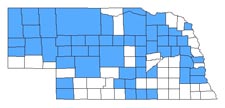
| Cicindela formosa Say |
| Adult Length: 13.5 to 18 mm |
| Appearance: Two subspecies of this insect can be found in Nebraska. Cicindela formosa generosa is limited to the easternmost edge of the state near the Missouri River. Cicindela formosa formosa is found across the remainder of the state. Intergrades between the two subspecies can be found from the eastern edge of the state west to Buffalo County, but most Buffalo County individuals exhibit purely formosa-like traits. Across this band of intergradation, those in the east tend to exhibit more generosa-like traits, while those to the west tend to exhibit more formosa-like traits.
Cicindela formosa generosa Dejean This subspecies exhibits extensive pale maculations. In comparison to ssp. formosa, the middle band typically drops down much more steeply toward the anal end, and the posthumeral band tends to be more elongated. The ground color is blackish to brown or dull red. Occasional individuals may have a weak bluish sheen. Intergrades with ssp. formosa exhibit more reddish colors, often appearing dark maroon or reddish brown. In such cases, the maculation also exhibits characteristics between both subspecies. “Pure bred” individuals might occur only along the eastern edge of the state, and are usually mixed with intergrade or normal nominate individuals. Cicindela formosa formosa Say This subspecies exhibits extensive pale maculations. In comparison with ssp. generosa, the middle band is usually much more straightened, and the posthumeral band shorter. The extent of maculation varies more widely than in ssp. generosa, the extremes of which are pictured here. Both of these extremes were collected from the Sandhills Province of central Nebraska. The ground color is red, but occasional individuals may be purplish. |
| Similar Species: The nominate subspecies can easily be confused with C. lengi. In C. lengi the bottom of the “foot” section of the middle band is as low or lower on the length of the elytra than the forwardmost part of the subapical dot, whereas in C. formosa formosa this is almost never the case. Cicindela formosa generosa may be mistaken for C. tranquebarica. In C. formosa generosa there is always a complete marginal band of pale maculation along the entire outer margin of each elytron. Though a complete marginal band may rarely occur in C. tranquebarica specimens from far western Nebraska, C. formosa generosa only occurs in the eastern part of the state. |
| Biology: This species inhabits dry sandy soils with sparse vegetation in upland areas. Preferred habitats include dunes and blowouts, sand pits, and a variety of other open sandy areas. Adults are relatively skittish, and often buzz off loudly when alarmed. |
| Adult Life History: Adults emerge briefly in late summer, mostly appearing in late August and early September. Adults remain active until middle and late September before overwintering. Adults resume activity in late spring, with adults appearing in May, and peak numbers in June. Numbers decline steadily in July, and few individuals survive until mid-August. The number of adults that emerge from the ground in fall is typically far less than are seen in early summer, and many likely remain underground after pupal emergence until spring. It is a spring-fall species. |
| Larval Life History: Larvae of this species have a unique burrow structure among Nebraska species. Burrows extend upward from as much as 1.2 meters deep, and bend horizontally just below the soil surface. The burrow opens above an often bow-shaped pit. The outer side of the bow is usually sloped, while the inner side is steep and usually somewhat undercut near the middle. The burrow opening occurs in this undercut area. The larvae wait for prey above the pit. Criddle (1910) found that larvae of this species feed almost exclusively on ants, and that the pit acts as a trap. Upon falling into the pit, the hapless ant is quickly grabbed and dragged into the burrow for consumption. The diameter of the pit in third-instar larvae can be up to 5 centimeters. This species probably has a two-year life cycle in most of Nebraska. Eggs are laid mostly in June and July. Most larvae reach the third instar by fall, overwinter, and become active again in spring. Pupation occurs in summer and new adults emerge in late August and September. Because this is a large species, it is likely that some larvae require three years of development. |
| Biogeography: This species is abundant throughout the Sandhills Province, occurring in most open areas. It is somewhat more limited in distribution in many other parts of the state, where it occurs in open sandy areas. In the Platte River Valley, it may often inhabit the drier parts of old sand pits and other sandy areas. In North America it occurs across most of the eastern United States east of the Rocky Mountains, but is lacking from most of the southeast. An isolated population occurs in western Colorado. Five subspecies have been described. |











